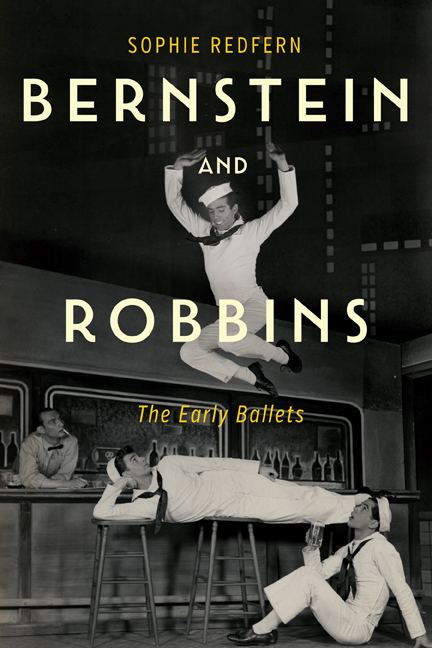Book contents
- Frontmatter
- Dedication
- Contents
- List of Illustrations
- Acknowledgments
- List of Abbreviations
- Editorial Note
- Preface
- 1 Setting the Scene: American Ballet and Jerome Robbins
- 2 Toward a First Ballet: Fancy Free Takes Shape
- 3 Creating Fancy Free: A Long-Distance Collaboration
- 4 The Music of Fancy Free: The Sketches and Score Explored
- 5 The Fancy Free Premiere and a Move to Broadway
- 6 Toward a Second Ballet: Bye Bye Jackie and the Creation of Facsimile
- 7 The Music of Facsimile: The Sketches and Score Explored
- 8 The Facsimile Premiere and Legacy of the Ballets
- Epilogue: Bernstein and Dance
- Bibliography
- Index
7 - The Music of Facsimile: The Sketches and Score Explored
Published online by Cambridge University Press: 23 March 2021
- Frontmatter
- Dedication
- Contents
- List of Illustrations
- Acknowledgments
- List of Abbreviations
- Editorial Note
- Preface
- 1 Setting the Scene: American Ballet and Jerome Robbins
- 2 Toward a First Ballet: Fancy Free Takes Shape
- 3 Creating Fancy Free: A Long-Distance Collaboration
- 4 The Music of Fancy Free: The Sketches and Score Explored
- 5 The Fancy Free Premiere and a Move to Broadway
- 6 Toward a Second Ballet: Bye Bye Jackie and the Creation of Facsimile
- 7 The Music of Facsimile: The Sketches and Score Explored
- 8 The Facsimile Premiere and Legacy of the Ballets
- Epilogue: Bernstein and Dance
- Bibliography
- Index
Summary
Structure
Facsimile focuses on the psychology of human relationships and to complement this Bernstein composed what he described as “neurotic music” that “mirrored the neuroses of the characters involved.” He revealed little else about his music for the ballet, but in a program note for the first performance of the concert version on March 3, 1947, he set out the four-part structure and the key events in the ballet's narrative (table 7.1). This was fixed from the early stages as a plan by the composer—showing two halves and four dances—on a sketch demonstrates:
I. a) Solo
b) Pas de deux
II. a) Pas de trois
b) Coda (Song)
The mention of a song is notable, and in other sketches there are references to “Curtain music” in Section I, but further investigation shows this lasted only a few measures and was incorporated into the “Solo.” It was therefore a four-part structure both musically and choreographically throughout its creation.
As to what was required, Bernstein needed to evoke a feeling of space and help convey the psychological drama unraveling, but no detailed scenario by Robbins or Bernstein has survived in any of the archives and it may well be that, in contrast to Fancy Free, none ever existed. The result is that there are fewer direct links between specific actions and the music in Facsimile than in their earlier ballet, and this may have been significant for Bernstein when composing the score. As this chapter demonstrates, in repurposing existing music he mostly turned to concert music, which by its very nature is abstract.
The Sketches
Three of the four dances in the Facsimile score include recycled music. In some cases Bernstein turned to completed works, while in other instances partial sketches provided the material. As with Fancy Free his compositional process can be traced through these manuscripts and the main musical sources detailing his work are autograph sketches in pencil, an autograph short score in pencil, autograph manuscripts in ink (fair copies), and the published score. The published score is of the concert version with a revised ending that Bernstein finished after the ballet's premiere and later published as Facsimile: Choreographic Essay for Orchestra (the subtitle was an addition for the concert version).
- Type
- Chapter
- Information
- Bernstein and RobbinsThe Early Ballets, pp. 203 - 235Publisher: Boydell & BrewerPrint publication year: 2021



